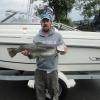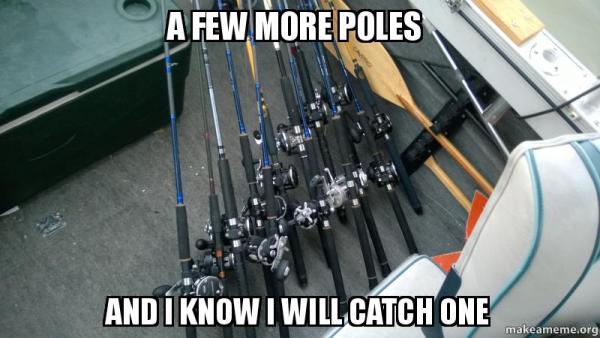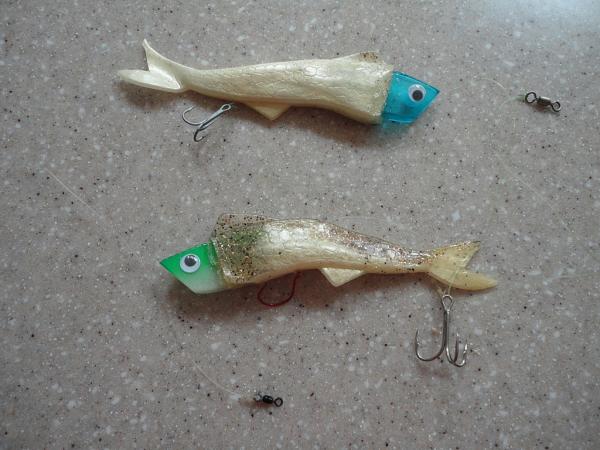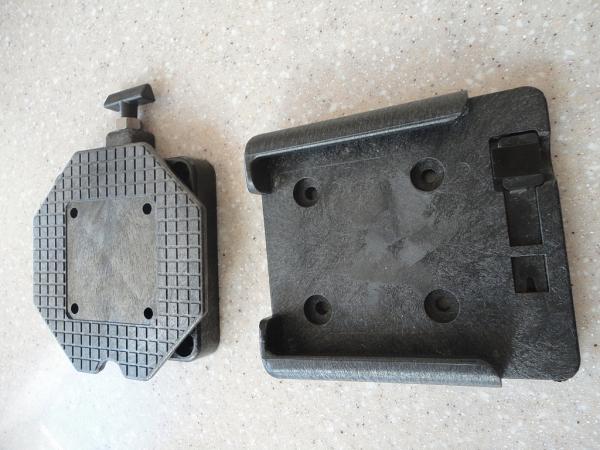-
Posts
13,872 -
Joined
-
Last visited
Everything posted by Sk8man
-
-
-
Screwey Louie"s in Fairhaven x2
-
Yeah I got my boat name The White Porcupine because of all the rods sticking up (thanks to Hop). I've even had the DEC guys check me out when fishing solo to see whether I was "legal" I've had as many as 15 onboard fishing by myself You can never have enough "stuff" Nick feels that way about his rod holders
-
-
Just for the record I have been using the bait heads and meat rigs for quite a few years and if you want to save money on bait go to artificials they last for years. I use both (and you don';t have to screw around stiffening with brine either). I guess the point I was making is that it doesn't have to be an "either or" siituation. I run Seth Greens, downriggers, pull copper, wire rigs, leadcore and coppers, use outriggers and big boards, inline boards and even the old Yellowbird boards as the situation dictates. Yes there are newer and easier ways to do things sometimes but part of the fun of it is doing different things and also using home made lures, flies and spoons etc. as well despite having thousands of commercial lures in the boxes. Newer is not always "better" either it is only "different".
-
-
i guess that is one way to look at it but sometimes it is productive to think of things along the line of "just one more thing in the arsenal" because they still do work and sometimes even when the fish won't take the "Michigan rigs" I still keep the earlier "dodgers" and the various versions of "cowbells" for the same reason despite using the hammerhead routinely and flashers and spinneys. It is always nice to be able to bring out the old stuff when the "new" stuff doesn't seem to be working....sometimes the result may surprise you The practical thing about the approach relates to "do whatever works" for you.
-
Thanks for that tip Harvey
-
I don't know if they have solved that problem themselves by now but at one point they were having difficulty getting someone to silver plate their own spoons.
-
I'm with overthelimit - braid for the eyes with fluoro leader and mono for trout and salmon with fluoro leader.
-
It might help if you identified exactly what type of fishing you are referring to because 3 way rigs can be used for a variety of setups on either saltwater or freshwater and for many species. With the 'erie" in your name my hunch is you are talking walleyes maybe?
-
As with many species a lot of it depends on how the fish is treated at the outset after being caught, the initial prep work done (e.g. filleting) and then how it is cooked. Lakers especially large ones can be somewhat oily and "fishy" if these things aren't done right. A lot of folks feel this about Bluefish in the salt water environment but when prepared right both can be delicious. Much of the fishy taste in lakers comes from the lateral line area (the dark grey area in the mid line of the sides of the fish, the back of the fish and the stomach area (most of the oil in the fat in these areas). It is not as pronounced in the smaller lakers but just as important to get rid of and the smaller ones are "milder" in taste. Probably the most important step other than removal of the lateral area happens when you first catch the fish. They should be "bled out" by making a large cut across the bottom area under the gills. To avoid a mess in the boat it can be done by placing them in the net over the side and letting the blood drain out of them. They then need to go immediately on ice right until filleted not just thrown in an iceless cooler to get "mushy". When they are filleted it is important to remove the thick part of the back area, the fatty areas of the underside and remove the skin (these are also the areas of greatest potential contaminants) and all bones (rib cage itself and the little bones above it) from the fish. Once boneless and skinless each fillet can be further processed by cutting out most or all the grey lateral area on the sides of the fish. Yes you will have less meat but what you have will be much less "fishy". A main reason people say lakers aren't good eating ios because they have either failed to process them properly or because they have heard others say they are poor quality and have not actually tried them. There are many ways to prepare them but I prefer coating them with olive oil and breading them with Panko ( Japanese bread crumbs) mixed with Old Bay seasoning. They can also (like Bluefish) be good with Cajun seasonings. I too believe that the lakers from the Finger Lakes seem better tasting but they are also usually smaller than the Lake O "beasts"
-
-
There are a number of different Herring sub types in the species but the ones in Seneca are called sawbellies or alewives and to my knowledge you can't introduce any other types of baitfish other than those listed on the DEC syllabus that you get at stores or bait shops etc. Last year I ran both a fresh frozen sawbelly and just slid his head in the meat rig and put a toothpick in the holes and then broke it off to hold it in place for one of them on the other that I also caught a laker on I made an artificial bait from a salt water jig body bait like these below. I placed a fairly rigid copper wire inside so I can bend them to twirl the right way
-
-
Hopefully you'll be able to see these pics clear enough to get the idea. There are different versions of the gangs for example a clasp or clip can be the first item in the series to hold the mouth of the bait shut instead of the small hook noted here. The key feature is to tie the series of three hooks (2 trebles and one single in front) so that the single hook or clip slides so that you can adjust the bait to size as well as tighten or loosen to give the bait the right amount of "twirl" behind the attractor. Basically you set the fixed trebles in a fixed position such that one will reside at the bottom center of the bait while the last one trails the end of the bait. The heavy duty thread is wound around the hook shaft securing the 40 lb mono to it making sure that the first single can slide with tension applied (it slides within the wound thread winding on the shaft of the hook). When all together coat the thread with lacquer or acrylic nail polish top coating. I hope you get the idea here I have a bunch tied somewhere but unable to locate tonight to show different versions. These are from the mid seventies Look closely at the eyelet on the first hook in the series it is bent backward which assists in the sliding adjustment.
-
-
-
That is true Nick. The one thing I have wondered though is if you were to be stopped by a conservation officer while out there and someone said they caught the bait out there rather than say getting it from an uncertified source how would they be able to make a determination? On the other side of it I'm sure they have a lot more things to do than check someones bait out unless maybe fishing from shore during a routine license check (e.g. still fishing) and then the question becomes how did you catch them from here on shore? I guess the more important thing is that we all try to keep the viruses and invasives from further spreading although it often seems as though the proverbial horse is already out of the barn.
-
I'm not sure about the actual procedure but I know you have to have a certification certificate or license which requires routine testing of your bait source for viruses and I believe it is several hundred dollars but not sure for how long it is good for either or whether you have to pay for or arrange for the testing services etc. Whenever the NYS bureaucracy gets involved it is always "messy" and "expensive".
-
-







